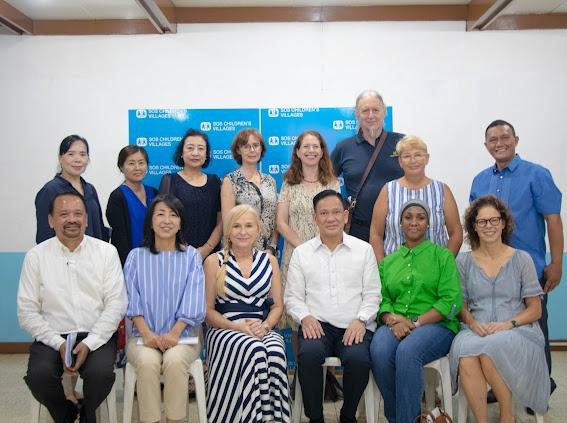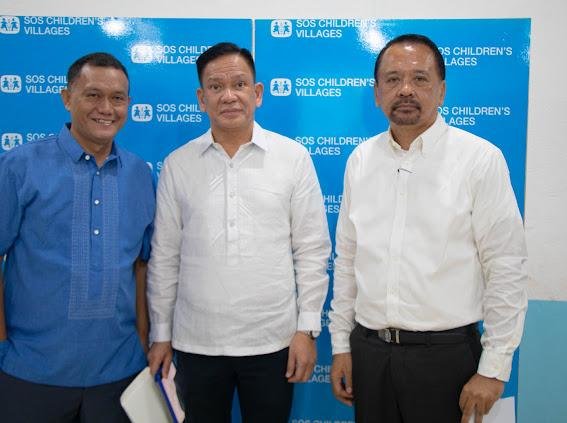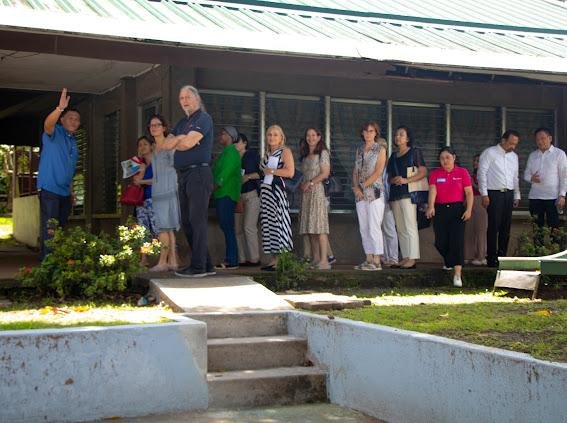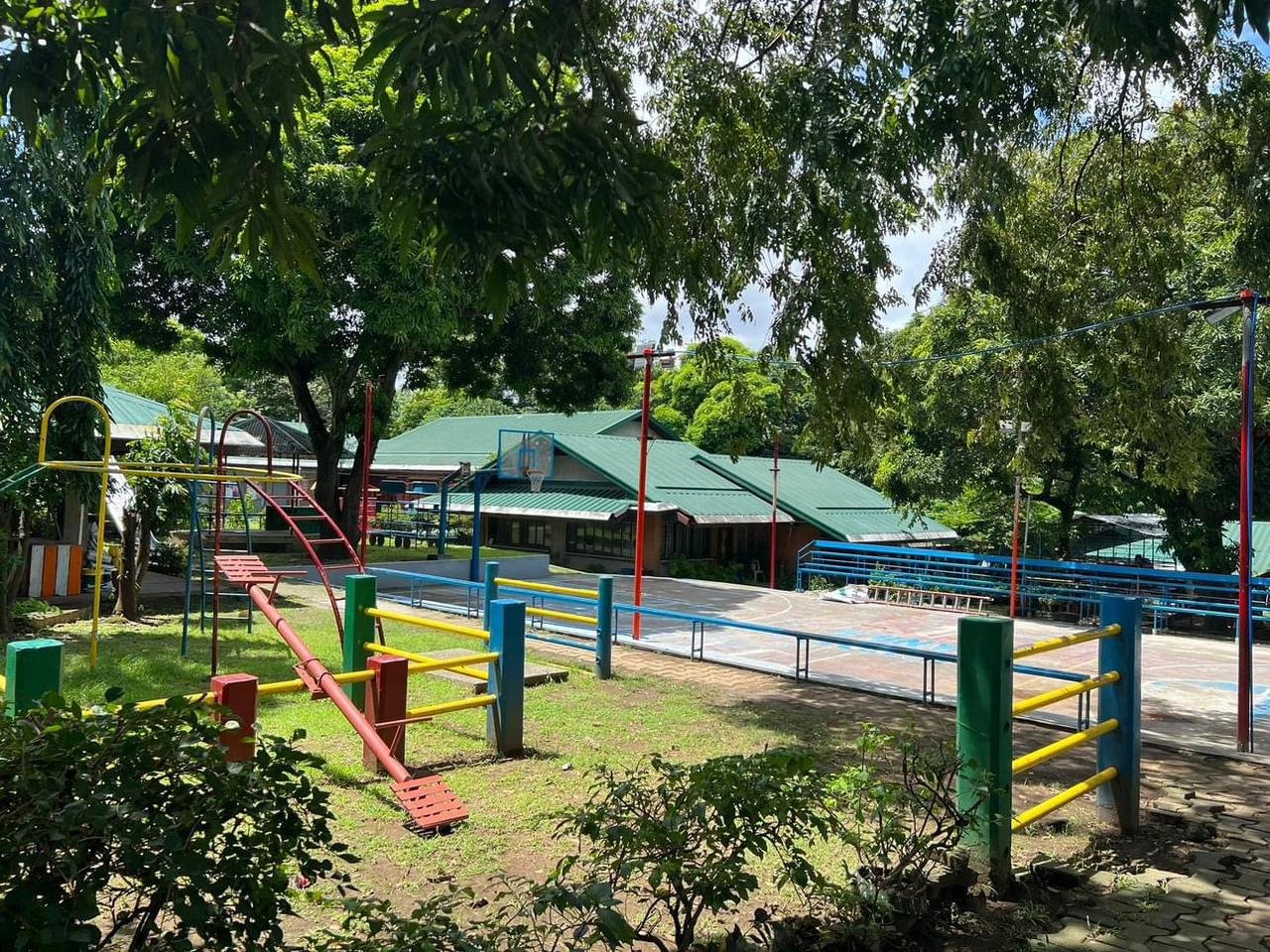SOS Children's Villages: A Haven for Children
Children playing in a place where they can be happy and safe. Image from SOS Children’s Villages flyer 2022.
Last October 6, 2023, The Spouses of Heads of Mission (SHOM) visited the SOS Children's Village in Alabang. SHOM consists of spouses of foreign ambassadors accredited to the Philippines, of which Mme. Roswitha Brieger, wife of Austrian Ambassador Johann Brieger, is a member. Also in attendance were other dignitaries, namely the wife of the Swiss Ambassador Mme. Denise Brühl-Moser, wife of the German Ambassador Mme. Marina Puhan Pfaffernoschke, wife of the Irish Ambassador Mme. Irene Colette Carlos, wife of the Israel Ambassador Mme. Gila Fluss Brachfeld, wife of the New Zealand Ambassador Mme. Riko Kell, wife of the Japanese Ambassador Mme. Koshikawa Yuko, wife of the Belgian Ambassador Mme. Miyahisa Chiemi, husband of the Swedish Ambassador Mr. Aaron Tovish, wife of the Laos Ambassador Mme. Bouavone Souksavanh and, lastly, the wife of the World Bank Country Director Mme. Soukeyna Diop. The purpose of their visit was to learn more about the SOS Children's Village to be one of the possible recipients of the proceeds of the International Bazaar that will be held on November 19, 2023, and other fundraising events. I was happy to know that the SOS Children's Village may be one of the recipients of the said bazaar, as I am familiar with and have had the opportunity to write about them here in 2018. In this piece, I will focus more on the institution's goals and what makes SOS Children's Village a cut above the rest regarding its holistic approach to child care and development.
The Spouses of the Heads of Mission in attendance last October 6, 2023. Image from the Austrian Embassy Manila and SOS Children’s Village in Alabang.
In 1949, Herman Gmeiner, a child welfare worker who served in the military during World War 2, founded the first SOS Children's Village in Tyrol, Austria. He saw how children suffered and were left orphaned due to the war and pioneered the family-based philosophy to help children who have lost parental care. In 1967, the first SOS Children's Village in the Philippines was established in Banay-banay, Lipa City, initiated by former Austrian Ambassador Dr. George Winternitz and his wife, Mrs. Susie Winternitz. Since beginning their work in the Philippines, SOS Children's Villages Philippines has supported thousands of children, youth, and families through alternative care and family strengthening programs. More than 70 years later, SOS Children's Village has become the number one global organization dedicated to providing a loving home for orphaned, abandoned, and neglected children.
From left to right: Raymond Rimando - Village Director of SOS Children’s Village Manila, Mel Sarmiento - Chairperson of the Board of Trustees of SOS Children’s Villages in the Philippines, Romil Rayos del Sol - Deputy National Director of SOS Children’s Villages in The Philippines. Image from the Austrian Embassy Manila and SOS Children’s Village in Alabang.
Since beginning their work in the Philippines, SOS Children's Villages Philippines has supported thousands of children, youth, and families through alternative care and family strengthening programs.
Family-like Care
SOS Children's Villages provide family-like care for children who have lost parental care. The children are cared for in a home with an SOS mother, siblings, and other children. These children receive quality care until they are ready to live independently. Four unique pillars guide the SOS family-like care, namely: The Mother, The Village, The House, and Brothers and Sisters.
The Mother
An SOS mother lives with the children and takes care of all the child's needs while respecting and considering where they came from -- culture, family background, and their story. Children have an emotional need for a loving and caring mother, and the SOS mother is always present to provide this for her children.
The Village
SOS families live together in one village and support each other in raising the children. With this support, children can feel part of and learn to participate in society actively.
The House
One house shelters up to ten children. Each child lives in a unique, loving home where they can build and create loving bonds with their SOS mother and other children.
Brothers and Sisters
Family ties that grow naturally offer children a sense of security and belongingness. Every child can live in a home with their biological and SOS siblings.
A tour around the Children’s Village. Image from the Austrian Embassy Manila and SOS Children’s Village in Alabang.
2. Family Strengthening Program
Through the Family Strengthening Program (FSP), SOS Children's Villages PH supports struggling families through counseling, skills training, and community-based programs to help families become self-reliant and provide proper care for their children.
Nutrition and Healthcare
SOS Children's Villages PH helps parents provide affordable, nutritious meals for the whole family through food assistance and a backyard garden inside the village.
Educational Assistance
SOS Children's Villages PH helps children complete their education through scholarships, stipends, and providing needed school materials. They also offer employability training, preparation for entrance and board exams, and partnership with local units.
Livelihood Programs
These help families establish a sustainable livelihood through income support, employability training, and other interventions, such as entrepreneurship, employable skills training, and financial management, to name a few.
Counseling
Families are provided with improving the approach to caring for their children through counseling on parenting capability, effective ways to communicate with their family members, and child protection laws/rights of the child.
3. Child Safeguarding
Many children all over the world still experience violence and abuse in many forms. Poverty and conflict make children more vulnerable to neglect, abuse, and exploitation. SOS Children's Villages works to create a safe home for children and break the cycle of violence. They work to minimize children's exposure to risks of abuse, neglect, violence, and exploitation and ensure that every child grows in a protective and caring environment.
Their work follows the UN Convention on the Rights of the Child, the Guidelines for the Alternative Care of Children, and the Child Protection Policy.
Child Protection Policy
One of the bases of their child safeguarding programs is the Child Protection Policy, which focuses on four key areas: Awareness, Prevention, Reporting, and Response.
Awareness. Breaking the silence on the topic of abuse by raising awareness of the signs of abuse as well as its prevention. Prevention. It is safeguarding the children from abuse by providing every child with a safe environment. Reporting. It is creating channels for reporting child safety concerns that are quick, transparent, accessible, and secure. Response Reports that concern a child's safety is taken seriously. Appropriate responses are made according to the report to ensure that everyone's rights are protected.
Spouse of the Austrian Ambassador Mme. Roswitha Brieger and other member of the SHOM engaging with the children. Image from the Austrian Embassy Manila and SOS Children’s Village in Alabang.
4. Youth Empowerment
Every child has the right to live independently and have a bright future. However, not all youth receive the needed guidance and support to make decisions regarding their education and career. SOS Children's Villages PH ensures that children and youth acquire equal and accessible opportunities in education and employment. Empowered youth can make decisions that positively affect their lives and participate actively in society.
Education and Training
The children and youth under their care receive education through scholarships and provide for their educational needs. They choose where and what to study while receiving guidance on independent living.
YouthCan
YouthCan! is a global partnership for youth employability. They aim to support young people in their transition to employment and independent living.
A place to call home. Image from the Austrian Embassy Manila and SOS Children’s Village in Alabang.
SOS Children’s Village is operating in 106 countries with 517 children villages and was able to assist 51,813 SOS children, youth and 332,928 families in the community! To date, there are eight SOS Villages here in the Philippines, and I hope that they continue to grow and establish more villages in the country. I'm also crossing my fingers that they will be chosen as one of the beneficiaries of the International Bazaar and other charitable events that the Spouses of the Heads of Mission will have in the future.
Indeed, the SOS Children's Village is a precious gift to the underprivileged children and youth of the Philippines. With their help, the children are properly taken care of, allowing not only a brighter future ahead for them but will also create a brighter future for the country.







